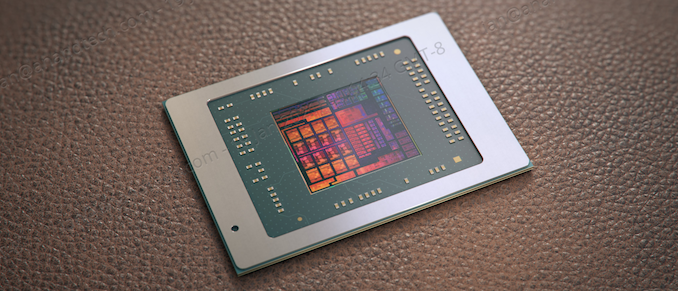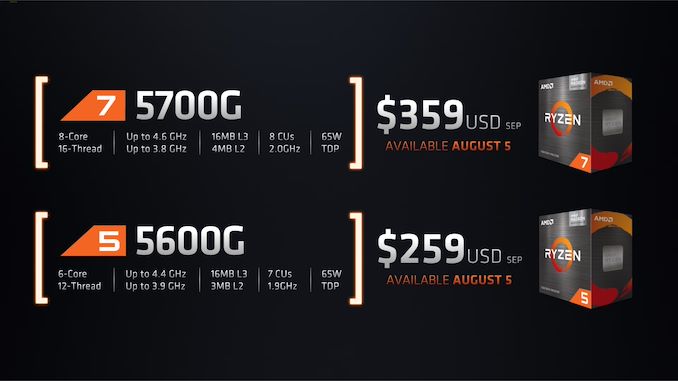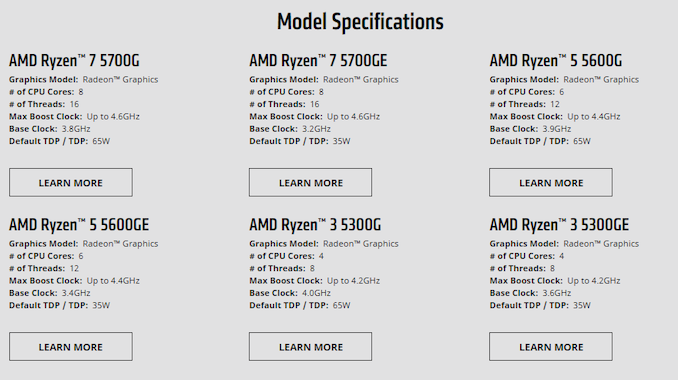AMD Ryzen 5000G: Zen 3 APUs for Desktop Coming August 5th
by Dr. Ian Cutress on May 31, 2021 10:40 PM EST- Posted in
- CPUs
- AMD
- APUs
- Trade Shows
- TSMC
- 7nm
- Zen 3
- 915
- N7
- Computex 2021
- Ryzen 5000G
- Vega 8

Back in April of this year, AMD announced its new series of Ryzen 5000G processors with integrated graphics. These processors were an upgrade over the previous generation of 4000G hardware by using AMD’s newest Zen 3 cores coupled with Vega 8 integrated graphics. At the time those processors were released for the pre-built system market only, with promises that retail versions would be made available later in the year. Today AMD is announcing two Ryzen 5000G models for retail, coming to market worldwide on August 5th.
Ryzen 5000 Gets a G
AMD runs two lines of processors: those without integrated graphics, which are often targeted for higher performance markets with a chiplet design, and those with integrated graphics which use higher powered versions of the equivalent mobile monolithic silicon. Normally we differentiate between the two by calling the first a CPU and the second an APU, and AMD gives the latter easily identifiable product names because they all end in a G, for graphics.
AMD has launched several generations of APUs built upon its Ryzen architecture:
- Ryzen 2000G (Raven Ridge), built on 14nm Zen with Vega 11
- Ryzen 3000G (Picasso), built on 12nm Zen+ with Vega 11
- Ryzen 4000G (Renoir), built on 7nm Zen 2 with Vega 8
- Ryzen 5000G (Cezanne), built on 7nm Zen 3 with Vega 8
The names in brackets are the official codenames for each of the processors. Because these APUs use the same silicon as the equivalent mobile processors, these desktop parts have the same codename as the mobile variants.
Both the 2000G and 3000G families were offered at retail, and the 3400G/2400G have both been popular processors. By contrast, we never saw a formal retail launch of Ryzen 4000G. This product line was focused for the pre-built market, especially for business ‘PRO’ use – AMD even stated at launch that these would likely never be offered for retail. The only way to get them has been to wait for hardware to filter through the resale market or hope that some pre-built vendors ordered too many and are selling them direct to end users. We ended up obtaining three of the APUs in this market, and put them to the test.
Testing The World’s Best APUs: Desktop AMD Ryzen 4750G, 4650G and 4350G
When the Ryzen 5000G family was first formally announced, AMD was again leading with the pre-built market. What made that launch different was that AMD also committed at the time to bringing the processor line to retail, so end-users could buy them on shelves in official retail packaging with a full warranty.
Out of the six processors that were initially launched, two of them are coming to retail on August 5th. AMD claims a worldwide launch.
| AMD Ryzen 5000G Series APUs | |||||||
| AnandTech | Core / Thread |
Base Freq |
Turbo Freq |
GPU CUs |
GPU Freq |
PCIe * |
TDP |
| Ryzen 5000G | |||||||
| Ryzen 7 5700G | 8 / 16 | 3800 | 4600 | 8 | 2000 | 16+4+4 | 65 W |
| Ryzen 7 5700GE | 8 / 16 | 3200 | 4600 | 8 | 2000 | 16+4+4 | 35 W |
| Ryzen 5 5600G | 6 / 12 | 3900 | 4400 | 7 | 1900 | 16+4+4 | 65 W |
| Ryzen 5 5600GE | 6 / 12 | 3400 | 4400 | 7 | 1900 | 16+4+4 | 35 W |
| Ryzen 3 5300G | 4 / 8 | 4000 | 4200 | 6 | 1700 | 16+4+4 | 65 W |
| Ryzen 3 5300GE | 4 / 8 | 3600 | 4200 | 6 | 1700 | 16+4+4 | 35 W |
| *PCIe lanes on the SoC are listed in GFX+Chipset+Storage | |||||||
Both of the launched processors come from AMD’s 65 W TDP line, so unfortunately we won’t have retail versions of the 35 W models right now. Both processors also have 24 lanes of PCIe 3.0 and will support DDR4-3200. These processors will be supported in 500-series motherboards with appropriate BIOS updates for full performance - 400-series support will depend on the manufacturer.
The top processor coming to retail is the Ryzen 7 5700G, with eight cores and sixteen threads, with a suggested retail price of $359. This processor has a base frequency of 3.8 GHz, a single core turbo frequency of 4.6 GHz, and will enable the full Vega 8 graphics at 2000 MHz.
The other processor is the Ryzen 5 5600G, with six cores and twelve threads, and a suggested retail price of $259. At a base frequency of 3.9 GHz and a single core frequency of 4.4 GHz, this processor will enable 7 compute units in the Vega integrated graphics at 1900 MHz.
Being based on the mobile cores means that these processors will have only 16 MB of L3 cache, which is half of the CPU variants without integrated graphics. Ironically enough usually a larger L3 cache helps integrated graphics, but as we are using the same silicon for mobile processors and APUs, some tradeoffs are made, mostly for the mobile side which is the bigger market for this silicon.
Comparing to Desktop CPUs
We've been asked to showcase the difference between the CPUs and APUs.
| AMD Ryzen 5600 Variants | |||||||||
| AnandTech | Core / Thread |
Base Freq |
Turbo Freq |
GPU CUs |
GPU Freq |
PCIe |
L3 MB |
TDP | SEP |
| Ryzen 5 5600X | 6 / 12 | 3700 | 4600 | - | - | 4.0 x24 | 32 | 65 W | $299 |
| Ryzen 5 5600G | 6 / 12 | 3900 | 4400 | 7 | 1900 | 3.0 x24 | 16 | 65 W | $259 |
If we put side by side the Ryzen 5 5600X, the CPU, with Ryzen 5 5600G, we see a lot of similarities. Both have six cores and 12 threads, both run at 65 W, and both have 24 PCIe lanes.
However, there are a number of differences as well. The 5600X CPU has an extra +200 MHz on the turbo frequency, whereas the 5600G APU has +200 on the base frequency and it also has integrated graphics. On top of this, the CPU has PCIe 4.0 rather than PCIe 3.0, and the CPU has double the cache.
The price difference puts the 5600X as more expensive by $40, but likely still the processor of choice for anyone wanting a fast discrete graphics card system.
If we go up to the 8-core parts, then that disparity changes a little.
| AMD Ryzen 7 5000 Variants | |||||||||
| AnandTech | Core / Thread |
Base Freq |
Turbo Freq |
GPU CUs |
GPU Freq |
PCIe |
L3 MB |
TDP | SEP |
| Ryzen 7 5800X | 8 / 16 | 3800 | 4700 | - | - | 4.0 x24 | 32 | 105 W | $449 |
| Ryzen 7 5700G | 8 / 16 | 3800 | 4600 | 8 | 2000 | 3.0 x24 | 16 | 65 W | $359 |
For this comparison, there is no base frequency difference, but the turbo is higher on the 5800X. The APU still has the integrated graphics, but is only PCIe 3.0 off the processor and not PCIe 4.0 like the CPU. We still have the cache difference.
So the question is which would you rather have - 100-200 MHz extra CPU frequency, double the L3 cache, and PCIe 4.0, or would you rather have integrated graphics? At a price differential of $90, now it suddenly got interesting.
Ryzen Pro 5000G and Full Ryzen 5000-Series Desktop Processor List
Alongside the two new Ryzen 5000G processors coming to retail, AMD is also announcing today a few additions to the Ryzen Pro stack at both the 65W and 35W power points. These are easily identifyable by the '50G' at the end of the name, and the 65 W models are identical to the non-Pro counterparts.
Adding in the pricing to our full processor list gives the following:
| AMD Ryzen 5000 Series Processors for Desktop Zen 3 Microarchitecture |
|||||||||
| AnandTech | Core/ Thread |
Base Freq |
1T Freq |
L3 C$ |
IGP | PCIe | TDP | SEP | |
| Ryzen 9 5950X | 16 | 32 | 3400 | 4900 | 64 MB | - | 4.0 | 105 W | $799 |
| Ryzen 9 5900X | 12 | 24 | 3700 | 4800 | 64 MB | - | 4.0 | 105 W | $549 |
| Ryzen 9 5900 | 12 | 24 | 3000 | 4700 | 64 MB | - | 4.0 | 65 W | OEM |
| Ryzen 7 5800X | 8 | 16 | 3800 | 4700 | 32 MB | - | 4.0 | 105 W | $449 |
| Ryzen 7 5800 | 8 | 16 | 3400 | 4600 | 32 MB | - | 4.0 | 65 W | OEM |
| Ryzen 7 5700G | 8 | 16 | 3800 | 4600 | 16 MB | Vega8 | 3.0 | 65 W | $359 |
| Ryzen 7 5700GE | 8 | 16 | 3200 | 4600 | 16 MB | Vega8 | 3.0 | 35 W | OEM |
| Ryzen 5 5600X | 6 | 12 | 3700 | 4600 | 32 MB | - | 4.0 | 65 W | $299 |
| Ryzen 5 5600G | 6 | 12 | 3900 | 4400 | 16 MB | Vega7 | 3.0 | 65 W | $259 |
| Ryzen 5 5600GE | 6 | 12 | 3400 | 4400 | 16 MB | Vega7 | 3.0 | 35 W | OEM |
| Ryzen 3 5300G | 4 | 8 | 4000 | 4200 | 8 MB | Vega6 | 3.0 | 65 W | OEM |
| Ryzen 3 5300GE | 4 | 8 | 3600 | 4200 | 8 MB | Vega6 | 3.0 | 35 W | OEM |
| Ryzen 5000 Pro | |||||||||
| Ryzen 7 Pro 5750G | 8 | 16 | 3800 | 4600 | 16 MB | Vega8 | 3.0 | 65 W | OEM |
| Ryzen 7 Pro 5750GE | 8 | 16 | 3200 | 4600 | 16 MB | Vega8 | 3.0 | 35 W | OEM |
| Ryzen 5 Pro 5650G | 6 | 12 | 3900 | 4400 | 16 MB | Vega7 | 3.0 | 65 W | OEM |
| Ryzen 5 Pro 5650GE | 6 | 12 | 3400 | 4400 | 16 MB | Vega7 | 3.0 | 35 W | OEM |
AMD has not commented about any other OEM-only processors coming to retail at this time.












34 Comments
View All Comments
ksec - Monday, May 31, 2021 - link
I am guessing they will keep Vega until ROCm support RDNA2?ET - Tuesday, June 1, 2021 - link
They will keep Vega until the next gen APUs. ROCm has nothing to do with this. ROCm APU support is spotty at best anyway.mode_13h - Tuesday, June 1, 2021 - link
AMD: Vega, ride or die!Santoval - Thursday, June 3, 2021 - link
They will keep Vega until it is on its deathbed and completely milked dry.. Four generations of APUs with Vega iGPUs and they are still beating the same dead horse. If Intel had not developed their Xe (i)GPUs AMD might have kept Vega alive for another 2 generations...mode_13h - Friday, June 4, 2021 - link
It is surprising they've kept it so long, but I think you're too pessimistic.RobATiOyP - Wednesday, June 16, 2021 - link
What APU outperforms those announced graphics?Even the R5 3400 provides useful gaming graphics, especially if you pair a monitor with display upscaling. Together that with 1440p gaming monitorcurrently costs less than an overpriced RX 580 or GTX 1060 mainstream dGPU.
mode_13h - Saturday, June 19, 2021 - link
> What APU outperforms those announced graphics?Tiger Lake U-series G7 models, with 96 EUs.
ikjadoon - Monday, May 31, 2021 - link
The pre-built OEM prices for these are excellent. You can get a HP Pavilion Ryzen 5700G / 16GB RAM desktop at Office Depot for under $700.8C Zen3 @ 4.6 GHz boost for $359 is absurdly good and outclasses Intel day & night. This is great to see from AMD; compete with yourself before Intel can even manage a sideways glance.
Link for the curious: https://www.officedepot.com/a/products/5448005/HP-...
ET - Tuesday, June 1, 2021 - link
You could get the Pavilion for $550 until recently, which I think was a good price, but the price got bumped up to $670. At $670 it's IMO only mediocre value, at best. It's a limited system, with no real expandability (you won't be able to use a discrete GPU) and single channel RAM (which means that you'll immediately have to shell more money for another stick). The only thing that makes it somewhat reasonable value is that it includes Windows 10 in the price.Alexvrb - Tuesday, June 1, 2021 - link
Prices are up across the board. What was a good deal half a year ago doesn't mean much today.